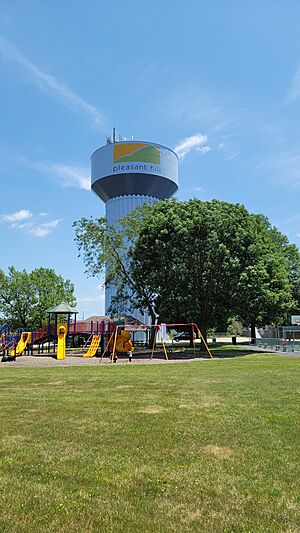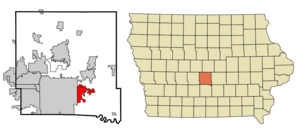Pleasant Hill, Iowa facts for kids
Quick facts for kids
Pleasant Hill, Iowa
|
|
|---|---|

Pleasant Hill's water tower, with the city logo
|
|

Location of Pleasant Hill, Iowa
|
|
| Country | United States |
| State | Iowa |
| County | Polk |
| Area | |
| • Total | 10.87 sq mi (28.15 km2) |
| • Land | 10.42 sq mi (26.99 km2) |
| • Water | 0.45 sq mi (1.15 km2) |
| Elevation | 906 ft (276 m) |
| Population
(2020)
|
|
| • Total | 10,147 |
| • Density | 973.58/sq mi (375.90/km2) |
| Time zone | UTC-6 (Central (CST)) |
| • Summer (DST) | UTC-5 (CDT) |
| ZIP codes |
50317, 50327
|
| Area code(s) | 515 |
| FIPS code | 19-63525 |
| GNIS feature ID | 2396230 |
Pleasant Hill is a city in Polk County, Iowa, in the United States. It's part of the larger Des Moines metropolitan area. In 2020, about 10,147 people lived there. Pleasant Hill even has its own ZIP code, 50327, assigned in 2005.
Contents
A Look Back at Pleasant Hill's History
Pleasant Hill officially became a city on May 12, 1956.
The 1983 Incident
On November 20, 1983, an explosion happened south of Pleasant Hill. It involved a storage area for explosives. The blast was very strong and could be felt far away, even 45 miles from the site.
Many homes nearby were damaged. Doors and windows were blown out, and some ceilings fell. Sadly, two people died in this event.
Understanding Pleasant Hill's Geography
Pleasant Hill covers a total area of about 9.29 square miles (24.06 square kilometers). Most of this area, about 9.15 square miles (23.70 square kilometers), is land. The rest, about 0.14 square miles (0.36 square kilometers), is water.
Who Lives in Pleasant Hill? Demographics
| Historical populations | ||
|---|---|---|
| Year | Pop. | ±% |
| 1960 | 397 | — |
| 1970 | 1,535 | +286.6% |
| 1980 | 3,493 | +127.6% |
| 1990 | 3,671 | +5.1% |
| 2000 | 5,070 | +38.1% |
| 2010 | 8,785 | +73.3% |
| 2020 | 10,147 | +15.5% |
| Source: and Iowa Data Center Source: |
||
Population in 2020
According to the census from 2020, Pleasant Hill had 10,147 people. There were 3,987 households and 2,822 families living in the city. The city had about 973.6 people per square mile (375.9 per square kilometer).
Most people in Pleasant Hill were White (84.5%). There were also Black or African American (3.5%), Asian (2.9%), and Native American (0.4%) residents. About 6.5% of people were from two or more races. Hispanic or Latino people made up 6.4% of the population.
The average age in the city was 39.6 years. About 26.7% of residents were under 20 years old. Also, 18.0% were 65 years or older. The population was 48.0% male and 52.0% female.
Population in 2010
In the census of 2010, there were 8,785 people living in Pleasant Hill. The city had about 960.1 people per square mile (370.7 per square kilometer).
Most residents were White (91.0%). Other groups included African American (2.7%), Asian (2.5%), and Native American (0.3%). About 4.5% of the population was Hispanic or Latino.
The average age was 35.1 years. About 27.4% of residents were under 18 years old. Also, 11.3% were 65 years or older. The population was 46.8% male and 53.2% female.
Learning and Schools in Pleasant Hill
Most of Pleasant Hill is part of the Des Moines Public School District. Newer parts of the city are in the Southeast Polk Community School District.
Pleasant Hill Elementary School (Des Moines district) and Four Mile Elementary School (Southeast Polk district) are in Pleasant Hill. The Southeast Polk Junior and Senior High Schools are also located here.
Getting Around: Transportation
The city's public transportation is provided by Des Moines Area Regional Transit. Route 10 offers bus service, connecting Pleasant Hill to other areas in the region.
See also
 In Spanish: Pleasant Hill (Iowa) para niños
In Spanish: Pleasant Hill (Iowa) para niños

